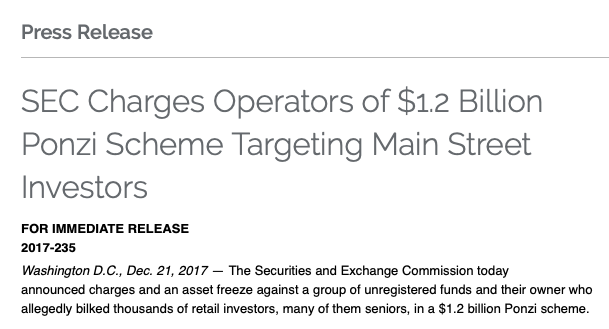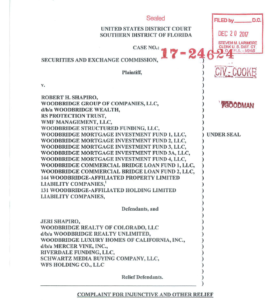Types Of SEC Cases: Commercial Lending Ponzi Scheme
SEC Charges Commercial Lending Ponzi Scheme With $1.22 Billion Unregistered Securities Fraud
The SEC filed a complaint against Robert H. Shapiro (“Shapiro”), his various “Woodbridge” entities, and numerous affiliated companies, alleging that Shapiro created a web of over 275 Limited Liability Companies (collectively the “LLCs” or “Woodbridge”) to carry out an immense commercial lending Ponzi scheme. After previously obtaining two court orders enforcing subpoenas against Woodbridge and 235 of the affiliated LLCs, the SEC filed this action to halt the loss of investor assets.
The SEC’s Press Release
Commercial Lending Ponzi Scheme Defrauded Thousands Of Investors
The SEC charged that Shapiro’s commercial lending Ponzi scheme raised over $1.22 billion from more than 8,400 unknowing investors across the United States through fraudulent unregistered securities offerings. In the complaint, the SEC asserted that Shapiro vowed to investors that his Woodbridge companies were generating 11-15% interest through commercial loans to third-party borrowers. In turn, investors would receive 5-10% annual interest and repayment from the proceeds generated by the high interest loans. However, the SEC alleged that almost all of the so-called borrowers were nothing more than additional limited liability companies owned and controlled by Shapiro to carry out his scheme. The companies had no assets and never paid any interest to Woodbridge. According to the SEC’s press release:“Our complaint alleges that Woodbridge’s business model was a sham,” said the Co-Director of the SEC’s Enforcement Division. “The only way Woodbridge was able to pay investors their dividends and interest payments was through the constant infusion of new investor money.”
Shapiro And Woodbridge Allegedly Spent Over $500 Million To Perpetrate The Commercial Lending Ponzi Scheme

The SEC’s court Complaint
The Commercial Lending Ponzi Scheme Collapses
According to the SEC, by year-end 2017, Shapiro and Woodbridge were unable to generate enough new investment capital to effectively pay investors their monthly dividends and interest payments, and the commercial lending Ponzi scheme collapsed. On December 4, 2017, Shapiro filed Chapter 11 bankruptcy for most of the LLCs. Due to the massive extent to which Shapiro supposedly carried out his scheme over a five and a half year period, the Commission believed that investors were owed at least $961 million in principal. The SEC further asserted that at least 2,600 of those investors were people who had unknowingly placed their retirement savings into Shapiro’s Ponzi scheme:“We allege that through aggressive tactics, Woodbridge and Shapiro swindled seniors into a business model built on lies, which the SEC’s Miami Regional Office staff moved to halt,” said the Co-Director of the SEC’s Enforcement Division. (Excerpt from the SEC’s press release.)
Defendants Charged With Fraud
The court complaint charged Shapiro, Woodbridge, and numerous affiliated companies with fraud and violations of the securities and broker-dealer registration provisions of the federal securities laws. Among other things, the SEC sought the return of the defendants’ alleged ill-gotten gains, along with interest and financial penalties. It also pursued a freeze of Shapiro’s and Woodbridge’s assets, and for the appointment of a receiver over Woodbridge and other related companies.Whistleblowers Can Report A Commercial Lending Ponzi Scheme Or An Unregistered Securities Fraud To The SEC
This case illustrates some types of misconduct that could give rise to SEC whistleblower cases if reported to the Commission through the SEC whistleblower program. However, the SEC has not made any public statement as to whether this case was itself an actual SEC whistleblower case. The SEC Office of the Whistleblower posts Notices of Covered Action (“NoCA”) for Commission actions where a final judgment or order results in monetary sanctions exceeding $1 million. The NoCA list does not disclose if a particular Enforcement action was brought as the result of an SEC whistleblower case, tip, complaint, or referral being filed with the Commission.Additional Information
For more information about Ponzi schemes and unregistered securities fraud, click on the links below:- The SEC’s court Complaint in SEC v. Shapiro, et al. (External link to the SEC’s website.)
- The SEC’s Press Release announcing the charges. (External link to the SEC’s website.)







